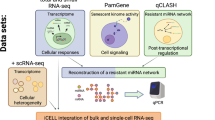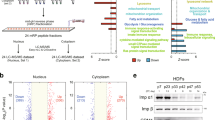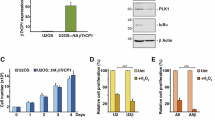Abstract
The nuclear receptor NR2E1 (also known as TLX or tailless) controls the self-renewal of neural stem cells (NSCs) and has been implied as an oncogene which initiates brain tumors including glioblastomas. Despite NR2E1 regulating targets like p21CIP1 or PTEN we still lack a full explanation for its role in NSC self-renewal and tumorigenesis. We know that polycomb repressive complexes also control stem cell self-renewal and tumorigenesis, but so far, no formal connection has been established between NR2E1 and PRCs. In a screen for transcription factors regulating the expression of the polycomb protein CBX7, we identified NR2E1 as one of its more prominent regulators. NR2E1 binds at the CBX7 promoter, inducing its expression. Notably CBX7 represses NR2E1 as part of a regulatory loop. Ectopic NR2E1 expression inhibits cellular senescence, extending cellular lifespan in fibroblasts via CBX7-mediated regulation of p16INK4a and direct repression of p21CIP1. In addition NR2E1 expression also counteracts oncogene-induced senescence. The importance of NR2E1 to restrain senescence is highlighted through the process of knocking down its expression, which causes premature senescence in human fibroblasts and epithelial cells. We also confirmed that NR2E1 regulates CBX7 and restrains senescence in NSCs. Finally, we observed that the expression of NR2E1 directly correlates with that of CBX7 in human glioblastoma multiforme. Overall we identified control of senescence and regulation of polycomb action as two possible mechanisms that can join those so far invoked to explain the role of NR2E1 in control of NSC self-renewal and cancer.
This is a preview of subscription content, access via your institution
Access options
Subscribe to this journal
Receive 50 print issues and online access
$259.00 per year
only $5.18 per issue
Buy this article
- Purchase on SpringerLink
- Instant access to full article PDF
Prices may be subject to local taxes which are calculated during checkout






Similar content being viewed by others
References
Liu HK, Belz T, Bock D, Takacs A, Wu H, Lichter P et al. The nuclear receptor tailless is required for neurogenesis in the adult subventricular zone. Genes Dev 2008; 22: 2473–2478.
Shi Y, Chichung Lie D, Taupin P, Nakashima K, Ray J, Yu RT et al. Expression and function of orphan nuclear receptor TLX in adult neural stem cells. Nature 2004; 427: 78–83.
Zhang CL, Zou Y, He W, Gage FH, Evans RM . A role for adult TLX-positive neural stem cells in learning and behaviour. Nature 2008; 451: 1004–1007.
Monaghan AP, Grau E, Bock D, Schutz G . The mouse homolog of the orphan nuclear receptor tailless is expressed in the developing forebrain. Development 1995; 121: 839–853.
Liu HK, Wang Y, Belz T, Bock D, Takacs A, Radlwimmer B et al. The nuclear receptor tailless induces long-term neural stem cell expansion and brain tumor initiation. Genes Dev 2010; 24: 683–695.
Modena P, Lualdi E, Facchinetti F, Veltman J, Reid JF, Minardi S et al. Identification of tumor-specific molecular signatures in intracranial ependymoma and association with clinical characteristics. J Clin Oncol 2006; 24: 5223–5233.
Park HJ, Kim JK, Jeon HM, Oh SY, Kim SH, Nam DH et al. The neural stem cell fate determinant TLX promotes tumorigenesis and genesis of cells resembling glioma stem cells. Mol Cells 2010; 30: 403–408.
Parsons DW, Jones S, Zhang X, Lin JC, Leary RJ, Angenendt P et al. An integrated genomic analysis of human glioblastoma multiforme. Science 2008; 321: 1807–1812.
Phillips HS, Kharbanda S, Chen R, Forrest WF, Soriano RH, Wu TD et al. Molecular subclasses of high-grade glioma predict prognosis, delineate a pattern of disease progression, and resemble stages in neurogenesis. Cancer Cell 2006; 9: 157–173.
Taylor MD, Poppleton H, Fuller C, Su X, Liu Y, Jensen P et al. Radial glia cells are candidate stem cells of ependymoma. Cancer Cell 2005; 8: 323–335.
Zou Y, Niu W, Qin S, Downes M, Burns DK, Zhang CL . The nuclear receptor TLX is required for gliomagenesis within the adult neurogenic niche. Mol Cell Biol 2012; 32: 4811–4820.
Sun G, Yu RT, Evans RM, Shi Y . Orphan nuclear receptor TLX recruits histone deacetylases to repress transcription and regulate neural stem cell proliferation. Proc Natl Acad Sci USA 2007; 104: 15282–15287.
Yokoyama A, Takezawa S, Schule R, Kitagawa H, Kato S . Transrepressive function of TLX requires the histone demethylase LSD1. Mol Cell Biol 2008; 28: 3995–4003.
Zhang CL, Zou Y, Yu RT, Gage FH, Evans RM . Nuclear receptor TLX prevents retinal dystrophy and recruits the corepressor atrophin1. Genes Dev 2006; 20: 1308–1320.
Zhao C, Sun G, Li S, Shi Y . A feedback regulatory loop involving microRNA-9 and nuclear receptor TLX in neural stem cell fate determination. Nat Struct Mol Biol 2009; 16: 365–371.
Qu Q, Sun G, Li W, Yang S, Ye P, Zhao C et al. Orphan nuclear receptor TLX activates Wnt/beta-catenin signalling to stimulate neural stem cell proliferation and self-renewal. Nat Cell Biol 2010; 12: 31–40 (sup), 31–39.
Simon JA, Kingston RE . Mechanisms of polycomb gene silencing: knowns and unknowns. Nat Rev Mol Cell Biol 2009; 10: 697–708.
Morey L, Pascual G, Cozzuto L, Roma G, Wutz A, Benitah SA et al. Nonoverlapping functions of the Polycomb group Cbx family of proteins in embryonic stem cells. Cell Stem Cell 2012; 10: 47–62.
O'Loghlen A, Munoz-Cabello AM, Gaspar-Maia A, Wu HA, Banito A, Kunowska N et al. MicroRNA regulation of Cbx7 mediates a switch of polycomb orthologs during ESC differentiation. Cell Stem Cell 2012; 10: 33–46.
Bracken AP, Dietrich N, Pasini D, Hansen KH, Helin K . Genome-wide mapping of Polycomb target genes unravels their roles in cell fate transitions. Genes Dev 2006; 20: 1123–1136.
Pemberton H, Anderton E, Patel H, Brookes S, Chandler H, Palermo R et al. Genome-wide co-localization of Polycomb orthologs and their effects on gene expression in human fibroblasts. Genome Biol 2014; 15: R23.
Gil J, Bernard D, Martinez D, Beach D . Polycomb CBX7 has a unifying role in cellular lifespan. Nat Cell Biol 2004; 6: 67–72.
Campisi J, d'Adda di Fagagna F . Cellular senescence: when bad things happen to good cells. Nat Rev Mol Cell Biol 2007; 8: 729–740.
Collado M, Blasco MA, Serrano M . Cellular senescence in cancer and aging. Cell 2007; 130: 223–233.
Kuilman T, Michaloglou C, Mooi WJ, Peeper DS . The essence of senescence. Genes Dev 2010; 24: 2463–2479.
Munoz-Espin D, Canamero M, Maraver A, Gomez-Lopez G, Contreras J, Murillo-Cuesta S et al. Programmed cell senescence during mammalian embryonic development. Cell 2013; 155: 1104–1118.
Storer M, Mas A, Robert-Moreno A, Pecoraro M, Ortells MC, Di Giacomo V et al. Senescence Is a developmental mechanism that contributes to embryonic growth and patterning. Cell 2013; 155: 1119–1130.
Hanahan D, Weinberg RA . Hallmarks of cancer: the next generation. Cell 2011; 144: 646–674.
Gil J, Peters G . Regulation of the INK4b-ARF-INK4a tumour suppressor locus: all for one or one for all. Nat Rev Mol Cell Biol 2006; 7: 667–677.
Bernard D, Martinez-Leal JF, Rizzo S, Martinez D, Hudson D, Visakorpi T et al. CBX7 controls the growth of normal and tumor-derived prostate cells by repressing the Ink4a/Arf locus. Oncogene 2005; 24: 5543–5551.
Scott CL, Gil J, Hernando E, Teruya-Feldstein J, Narita M, Martinez D et al. Role of the chromobox protein CBX7 in lymphomagenesis. Proc Natl Acad Sci USA 2007; 104: 5389–5394.
Forzati F, Federico A, Pallante P, Fedele M, Fusco A . Tumor suppressor activity of CBX7 in lung carcinogenesis. Cell Cycle 2012; 11: 1888–1891.
Karamitopoulou E, Pallante P, Zlobec I, Tornillo L, Carafa V, Schaffner T et al. Loss of the CBX7 protein expression correlates with a more aggressive phenotype in pancreatic cancer. Eur J Cancer 2010; 46: 1438–1444.
Muller H, Bracken AP, Vernell R, Moroni MC, Christians F, Grassilli E et al. E2Fs regulate the expression of genes involved in differentiation, development, proliferation, and apoptosis. Genes Dev 2001; 15: 267–285.
Gui H, Li ML, Tsai CC . A tale of tailless. Dev Neurosci 2011; 33: 1–13.
Barradas M, Anderton E, Acosta JC, Li S, Banito A, Rodriguez-Niedenfuhr M et al. Histone demethylase JMJD3 contributes to epigenetic control of INK4a/ARF by oncogenic RAS. Genes Dev 2009; 23: 1177–1182.
Banito A, Rashid ST, Acosta JC, Li S, Pereira CF, Geti I et al. Senescence impairs successful reprogramming to pluripotent stem cells. Genes Dev 2009; 23: 2134–2139.
Mohammad HP, Cai Y, McGarvey KM, Easwaran H, Van Neste L, Ohm JE et al. Polycomb CBX7 promotes initiation of heritable repression of genes frequently silenced with cancer-specific DNA hypermethylation. Cancer Res 2009; 69: 6322–6330.
Zhang XW, Sheng YP, Li Q, Qin W, Lu YW, Cheng YF et al. BMI1 and Mel-18 oppositely regulate carcinogenesis and progression of gastric cancer. Mol Cancer 2010; 9: 40.
Gargiulo G, Cesaroni M, Serresi M, de Vries N, Hulsman D, Bruggeman SW et al. In vivo RNAi screen for BMI1 targets identifies TGF-beta/BMP-ER stress pathways as key regulators of neural- and malignant glioma-stem cell homeostasis. Cancer Cell 2013; 23: 660–676.
Brookes S, Rowe J, Ruas M, Llanos S, Clark PA, Lomax M et al. INK4a-deficient human diploid fibroblasts are resistant to RAS-induced senescence. Embo J 2002; 21: 2936–2945.
Acosta JC, O'Loghlen A, Banito A, Guijarro MV, Augert A, Raguz S et al. Chemokine signaling via the CXCR2 receptor reinforces senescence. Cell 2008; 133: 1006–1018.
Lim DA, Alvarez-Buylla A . Interaction between astrocytes and adult subventricular zone precursors stimulates neurogenesis. Proc Natl Acad Sci USA 1999; 96: 7526–7531.
Scheffler B, Walton NM, Lin DD, Goetz AK, Enikolopov G, Roper SN et al. Phenotypic and functional characterization of adult brain neuropoiesis. Proc Natl Acad Sci USA 2005; 102: 9353–9358.
Acosta JC, Banito A, Wuestefeld T, Georgilis A, Janich P, Morton JP et al. A complex secretory program orchestrated by the inflammasome controls paracrine senescence. Nat Cell Biol 2013; 15: 978–990.
Maertens GN, El Messaoudi-Aubert S, Racek T, Stock JK, Nicholls J, Rodriguez-Niedenfuhr M et al. Several distinct polycomb complexes regulate and co-localize on the INK4a tumor suppressor locus. PLoS One 2009; 4: e6380.
Zhang Y, Liu T, Meyer CA, Eeckhoute J, Johnson DS, Bernstein BE et al. Model-based analysis of ChIP-Seq (MACS). Genome Biol 2008; 9: R137.
Acknowledgements
We are grateful to G Dharmalingam and S. Khadayate for help with bioinformatics and to I Fariñas and JM Morente for advise and help with NSCs. Core support was received from MRC and grants from MRCT, CRUK and the AICR funded the research in J Gil’s laboratory. N Martin was funded by EMBO and Marie Curie fellowships. J Gil is also supported by the EMBO Young Investigator Program.
Author information
Authors and Affiliations
Corresponding author
Ethics declarations
Competing interests
The authors declare no conflict of interest.
Additional information
Supplementary Information accompanies this paper on the Oncogene website
Supplementary information
Rights and permissions
About this article
Cite this article
O'Loghlen, A., Martin, N., Krusche, B. et al. The nuclear receptor NR2E1/TLX controls senescence. Oncogene 34, 4069–4077 (2015). https://doi.org/10.1038/onc.2014.335
Received:
Revised:
Accepted:
Published:
Issue date:
DOI: https://doi.org/10.1038/onc.2014.335
This article is cited by
-
Exploring the molecular basis of diapause I induction in the annual killifish Garcialebias charrua: a transcriptomic approach
Environmental Biology of Fishes (2024)
-
Stable expression of a truncated TLX variant drives differentiation of induced pluripotent stem cells into self-renewing neural stem cells for production of extracellular vesicles
Stem Cell Research & Therapy (2022)
-
Ranking genomic features using an information-theoretic measure of epigenetic discordance
BMC Bioinformatics (2019)
-
Molecular mechanisms underlying gliomas and glioblastoma pathogenesis revealed by bioinformatics analysis of microarray data
Medical Oncology (2017)
-
TLX—Its Emerging Role for Neurogenesis in Health and Disease
Molecular Neurobiology (2017)



